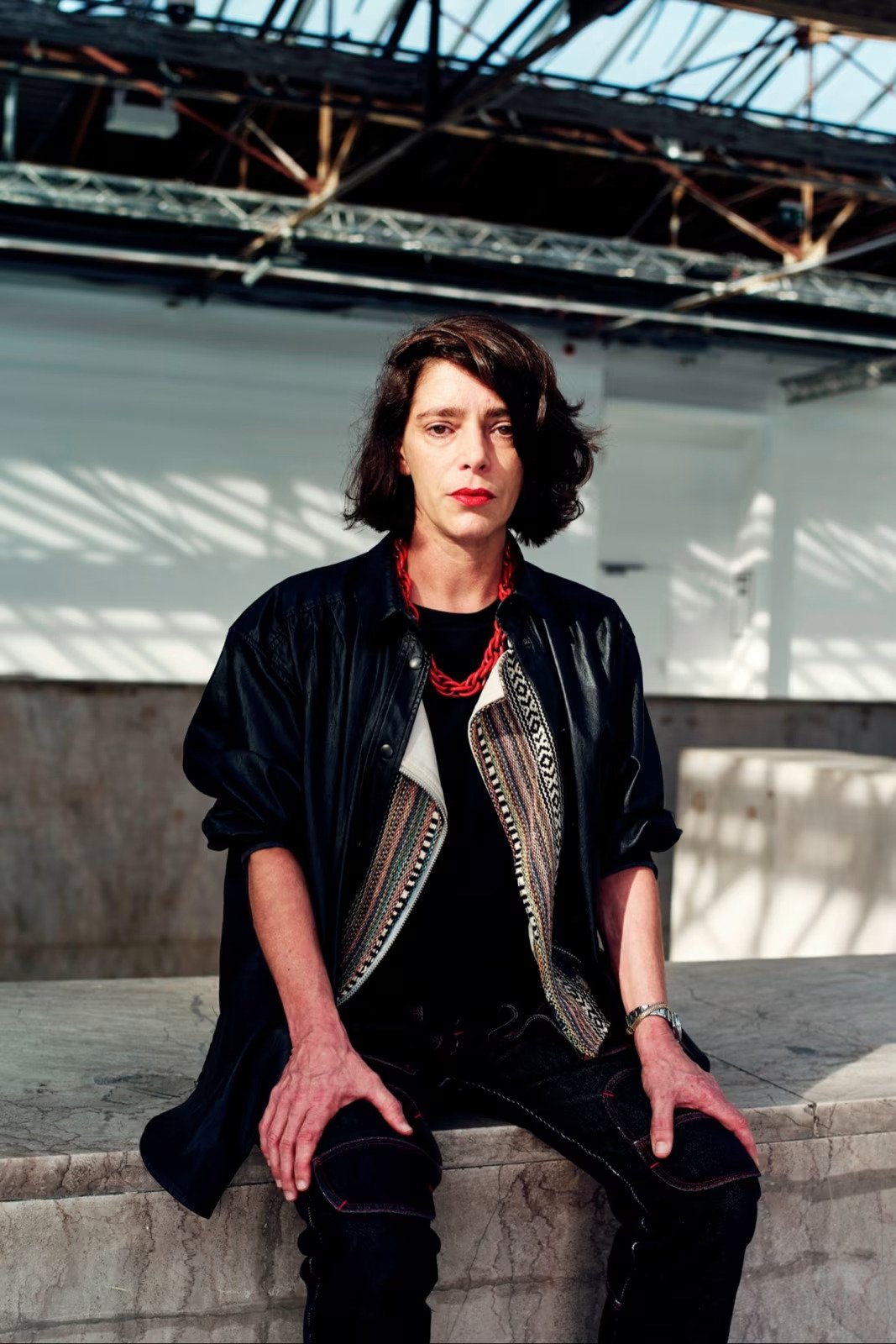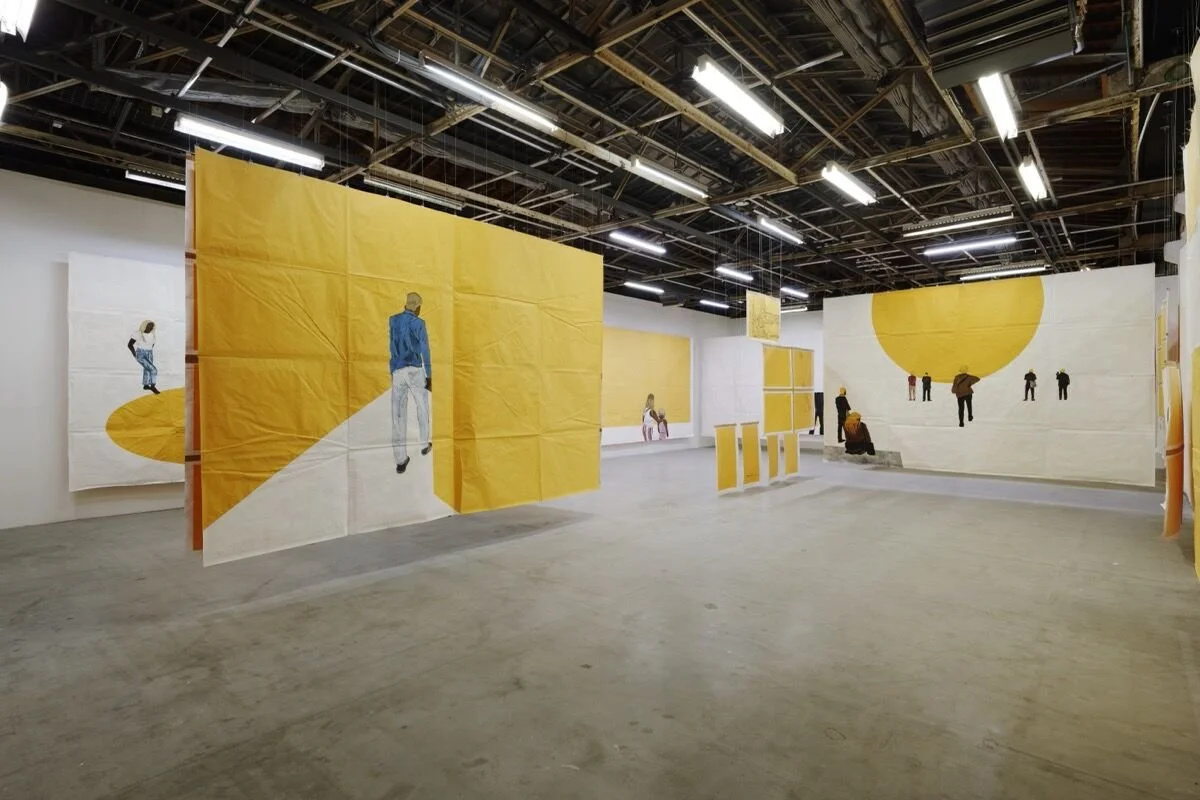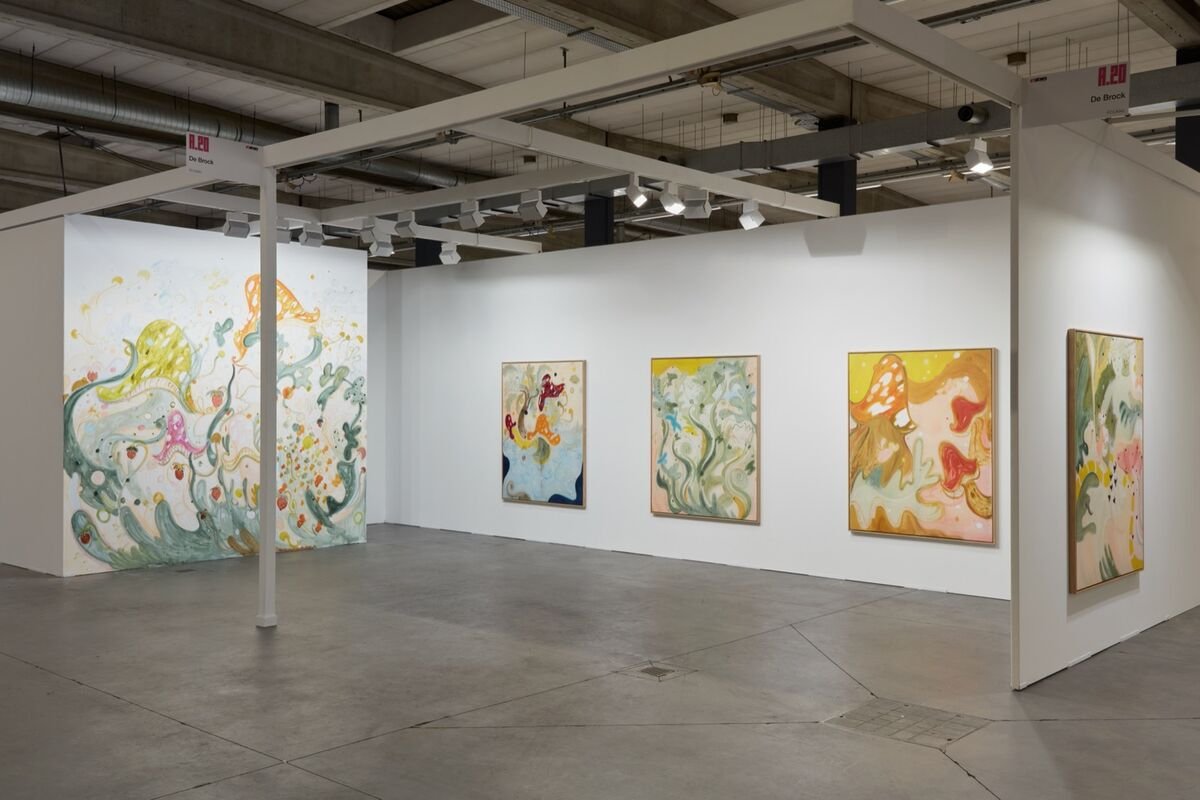Arte Povera responded directly to Italy’s postwar economic boom, aided by the US Marshall Plan. During that time, northern cities like Turin and Milan industrialized rapidly, leading to mass migration from the south. By the late 1960s, Cold War tensions were escalating, and the Italian Communist Party was gaining significant political influence, earning 12.6 million votes in the 1976 general election. During these “Years of Lead” (late 1960s–late ’80s), terrorist paramilitary groups—some covertly supported by the NATO project Gladio—battled police, bombed train stations, and even murdered the Christian Democrat President Aldo Moro.
The 17th Lyon Biennale Gets Personal
The 17th Lyon Biennale kicked off at the end of September to great pomp. As guest curator Alexia Fabre announced to a crowd of journalists, this year’s edition is informed by ideas of personal relations, altruism and welcoming the other – vague but not irrelevant topics given how close France came to electing the far-right National Rally Party in July of this year.
Among the most memorable works in the Grandes Locos – a former train-repair depot which serves as the biennial’s main site – is Gözde İlkin’s The Majority of Accent (2018–24), a mixed-media work in which the artist’s characteristic biomorphic figures are painted and embroidered onto the surface of a large textile print of a quarry. The work evokes the venue’s industrial past via images of labour organizing, accompanied by recorded interviews with former workers emitted from speakers hidden in printed, painted and embroidered sacks.
Paris Gallery Weekend marks a decade of progress
Paris Gallery Weekend has undergone significant changes in the past decade. Although it is now a city-spanning exploration of dealerships and institutions, the first edition, staged in 2014, consisted of a single group show of artists nominated by their respective galleries. This year’s iteration retained something of that initial concept through an initiative called Cartes Blanches, in which a dozen dealers invited curators to organise exhibitions of whatever they desired in their galleries.
Arthur Simms Builds a Web of Cultural Identity
For Édouard Glissant, the Martinican philosopher and poet, the archipelago wasn’t merely a unique geographical formation but a metaphor for understanding identity, culture and human relationships. This perspective comes alive in the works of New York-based Jamaican artist Arthur Simms, whose creations are currently on view at Kunstmuseum St. Gallen in Switzerland. The exhibition, titled ‘Chair with my Hair’, echoes Glissant’s vision of the Caribbean archipelago, highlighting the intricate dance between roots – our connection to cultural heritage and history – and routes: the paths of movement, exploration and cultural exchange.
An Exhibition in Paris Confronts the Brutalization of Women
Galindo’s videos and photographs document performances in which she positioned herself in scenes of staged precarity and abuse as a way of representing violence against women in her native country. The works on display range from somewhat absurd images – La Sombra (The Shadow, 2017), for instance, in which the subject runs towards the camera as a tank rolls behind her – to the less graphic but more disturbing video-performance La Verdad (The Truth, 2013). In this piece, Galindo reads aloud first-hand accounts of rape and genocide during the 36-year Guatemalan Civil War. La Verdad is punctuated by the intervention of a dentist, who periodically injects local anaesthetic into her mouth, causing her speech to slur. It is the most potent work in the show for the way that it stages and dramatizes a history of physical and sexual violence and for its allusion to ongoing forms of government censorship, obfuscation and forgetting. In works such as a still from the video of the performance Piel (Skin, 2001), the artist utilizes her naked body as a conduit for articulating the reification of women. However, La Verdad feels more impactful because it is the only piece in the exhibition where the brutalized women speak. Even if the viewer cannot see their faces nor knows their names, Galindo’s ventriloquizing of her own voice to bear witness for these women’s suffering offers them agency and presence in a way that the other works do not.
Ali Cherri Challenges the Western Gaze
Dressed in loosely fitting black clothes and a denim jacket, Paris-based Lebanese artist Ali Cherri glides through the Oriental Antiquity galleries of the Louvre like a dancer engaged in a complex choreography with the throngs of museum visitors around him. We stop before a relief panel depicting the Tree of Life taken from the Palace of King Sargon II at Dur-Sharrukin (c.713–706 BCE). Cherri has been studying this panel for several months in preparation for his forthcoming exhibition at the Giacometti Foundation, Paris, in January. The artist pulls out his phone to show me the progress being made on a 3D interpretation that will be the centrepiece of his show. ‘It is the first time that I will be working in bronze,’ he explains excitedly, swiping past images of the scale plaster model and screenshots of conversations with his chief studio assistant, Valentin Rolovic. Rolovic oversees five other assistants, some of whom I recently observed at the artist’s Paris studio constructing semi-transparent cactus leaves out of resin and massive heads out of styrofoam and fibreglass for ‘Dreamless Night’, an exhibition at Bergamo’s Galleria d’Arte Moderna e Contemporanea, which opened in early October.
Artist Lili Reynaud-Dewar: ‘I think we attribute too much power to art’
Lili Reynaud-Dewar had to go to Scotland to learn about France. The artist, born in La Rochelle on the western coast of France in 1975, moved to the UK to study for a masters in fine art at the Glasgow School of Art in 2001. “I didn’t realise until then how male-dominated the French contemporary art word was. There were artists that I admired very much, but there was very little place for women,” she says.
LE CHEF-D’ŒUVRE DU MOMENT : “ZERO TO INFINITY” DE RASHEED ARAEEN
Cet été, Zero to Infinity, sculpture participative de Rasheed Araeen, a transformé le Turbine Hall de la Tate Modern : “Ce qui n’était au départ que 400 cubes disposés dans un carré est aujourd’hui une structure en perpétuelle évolution”, comme le dit le musée. Araeen est un des pionniers de la sculpture minimaliste au Royaume-Uni, mais un minimalisme que l’on peut exceptionnellement toucher. Retour sur l’histoire d’une œuvre au long cours.
Vojtěch Kovařík Portrays a Forlorn Hero
Vojtěch Kovařík’s exhibition ‘The Labours of Hercules’ at Mendes Wood DM tells the story of one of art history’s most frequently illustrated iconographical subjects. Although the title alludes to the 12 tasks carried out by the classical hero Hercules as penitence for having killed his wife and children – after his stepmother, Hera, turned him temporarily insane – only one of the 12 paintings on display directly references its subject (Hercules Dips his Arrows in the Hydra’s Poisonous Black Blood, all works 2023). In marked contrast to the exalted attitudes of most representations of the scene, Kovařík does not depict Hercules triumphantly in medias res. Rather, the viewer is treated to a quiet, even melancholic portrayal. The massive, marble-white figure of Hercules is almost too big to be contained within the picture frame, and there is a look of forlorn concentration on the hero’s face.
At Art Brussels 2023, Emerging Artists and Rediscovered Masters Shine
Art Brussels is a fair much like the city it occupies. Perhaps not as iconic or flashy as Paris, New York, or London, Brussels is, nonetheless, a plucky, punchy European capital that refuses to be passed over or cede its cultural centrality to the European art world.
Two years after the pandemic forced the 55-year-old fair to adopt a clumsy hybrid of online sales and a city-wide gallery crawl, Art Brussels has triumphantly returned to Brussels Expo, also known as the Palace of Exhibitions—an imposing, almost Stalinist, Art Deco tower perched upon the Heysel Plateau, on the northern outskirts of the city. From its sprawling terraced emmarchement, visitors on the doorstep of the fair can look back upon a sweeping vista of the verdant surrounding park with the city’s iconic Atomium looming large in the distance.
The fact that this impressive setting is quickly put out of a visitor’s mind is a testament to the quality and vitality of the works on display inside. This year’s edition presents 152 galleries from 32 countries with more than 800 artists on display. Booths are divided into five unequally sized sections: Prime, Solo, Discovery, Rediscovery, and Artistic Project.
Laura Poitras “Toute la beauté et le sang versé”
Le film Toute la beauté et le sang versé de Laura Poitras s’ouvre sur un petit groupe de militantes agglutinées sur le trottoir près du Metropolitan Museum of Art (Met) de New York. Un complot est en train de se nouer. Ensuite, des images de l’intérieur du Met. La caméra fait un panoramique sur l’enseigne de l’aile où se trouve la collection égyptienne : l’aile Sackler, ces méga-mécènes du monde de l’art qui ont fait fortune dans la fabrication d’opioïdes hyper addictifs. Les gardiens renvoient des regards méfiants. Puis quelqu’un se met à crier : “Honte à Sackler”. Les autres se joignent à lui comme un chœur grec. Les vestes tombent au sol, révélant des t-shirts ornés des initiales “P.A.I.N” (Painkiller Addiction Intervention Now). Des flacons de pilules oranges sont jetés en l’air et dans le bassin autour du temple d’Isis de Dendur. Alors que les gardiens tentent frénétiquement d’arracher les banderoles, les activistes mettent en scène un die-in – simulant la mort. À la fois performance et manifestation, ils tombent au sol, mous et immobiles, à l’exception de leur chant continu.
Cerith Wyn Evans Reimagines Duchamp and Stella
Cerith Wyn Evans is the type of artist whose engagement with the forms and figures of modern art makes his work a joy to look at – especially for those able to untangle its dense web of references. For his most recent exhibition, ‘no realm of thought…’ at Marian Goodman, Paris – one of a two-part exhibition happening concurrently at the gallery in New York – Evans converses with the likes of Marcel Duchamp, Félix Guattari, Frank Stella and David Tudor.
Alice Neel’s Portraiture and Politics
Indeed, rather than two sections divided by a wall – an unfortunate Cold War metaphor if ever there was one – the exhibition could be viewed as an expansive survey, a growing family or an inventory of universal humanism. There is something about the way that Neel depicts bodies – often fat, flaccid and wrinkled, circumscribed with heavy black contours and modelled with undulating impasto brushstrokes – which almost seems to caress their flickering forms into being. Her fearless and loving approach to rendering the human figure in all of its beauty, ugliness and diversity speaks to Neel’s warmth, love and openness towards others. To that end, Pompidou’s mezzanine-level gallery is perfect for this small, dense retrospective. Connected to the pedestrian streets outside by floor-to-ceiling windows, this space gives visitors the impression of being, like Neel’s painting, among and with the masses of humankind.
Ângela Ferreira’s Radio of Resistance
‘Friends, comrades, this is Rádio Voz da Liberdade, on behalf of the Patriotic Front for National Liberation …’ The voice of Portuguese communist broadcaster Stella Piteira Santos echoes up from the lower level of the Regional Contemporary Art Fund (FRAC) in Marseille. The space is currently host to Ângela Ferreira’s ‘Rádio Voz da Liberdade’, the Portuguese artist’s homage to the guerrilla radio station broadcast in Algeria from 1962 to 1974 by exiled Portuguese dissidents of António de Oliveira Salazar’s dictatorship.
Graines at the 104 in Paris
Grains' encourages viewers to cherish the beauty of nature, but its case for biodiversity is only superficial.
Russian invasion puts Ukraine’s Venice Biennale pavilion on hold
On Thursday morning, Ukrainians in various cities awoke to explosions as the Russian military initiated an invasion of the neighbouring country by land, sea and air. In the early hours of the assault, its implications for the Ukrainian Pavilion at the Venice Biennale, which opens in April 2022, might have seemed like an afterthought. But Russia’s total war on Ukraine promises to have total consequences, not just for the Russian stock market and the energy supply of central Europe, but also for the Ukrainian cultural sector.
Max Pinckers's Fantastic Fictions
‘Double Bind’, Max Pinckers’s first museum retrospective, at FOMU Photo Museum Antwerp, presents five of the Belgian artist’s projects from the past half-decade. Each embodies his critical stance on the truth claims of photography, an approach that Pinckers terms ‘Speculative Documentary’. Conceived with fellow artists Thomas Bellinck, Michiel De Cleene and An van. Dienderen (a grouping that refer to themselves as The School of Speculative Documentary), the theory seeks to problematize various documentary formats – from photography and film to theatre and performance – blurring the line between reality and fiction.
Maxwell Alexandre’s Debut at Palais de Tokyo Considers Power Dynamics in Art Spaces
Maxwell Alexandre’s exhibition “New Power,” currently on view at the Palais de Tokyo in Paris through March 20th, was inspired in part by the 2018 music video for “Apeshit” by Beyoncé and Jay-Z. The hip-hop couple’s triumphant traipsing through Europe’s most famous museum, the Louvre, reignited conversations about the sociology of museum visitors; the value and accessibility of culture; and above all, the tension between the museum’s pretentions of being a democratizing, educational space despite the troubled histories of colonialism and plunder that had built up its collections. The global resurgence of racism and xenophobia, exemplifed by the presidencies of Donald Trump in the United States and Jair Bolsonaro in Brazil, seemed to lend these concerns additional urgency.
The 7 Best Booths at Art Antwerp 2021
The inaugural edition of Art Antwerp opened on Thursday to a modest but determined crowd of collectors and art professionals who filled the halls of the Antwerp Expo event center, on the Flemish city’s southside. A new art fair on the European circuit, Art Antwerp is an extension of Art Brussels, one of Europe’s longest running and most prominent fairs.
The fair features 59 galleries, the vast majority of which are Belgian, with the rest filled out by the bordering countries of France, Germany, Luxembourg, and the Netherlands, with the exception of one Austrian gallery. Yet despite its size and parochiality, Art Antwerp demonstrated that fairs don’t need sprawling global monoliths to pack a powerful punch. Sometimes, less is more. Indeed, the vast majority of the participating galleries appeared to have brought their A game, with a particularly strong showing of young figurative painters.



















